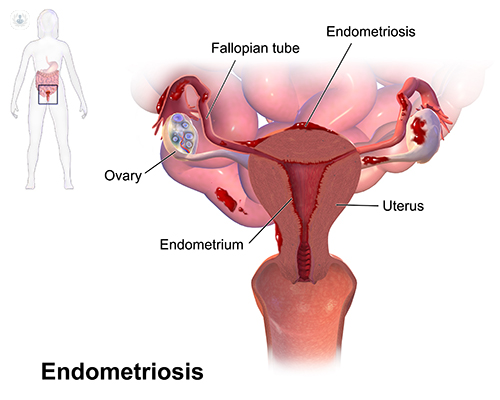Endometriosis: how it can affect the woman and what possibilities of treatment there are
Written by:The uterine cavity is covered by a layer called the endometrium; This layer is growing and transforming throughout the cycle, is preparing, as if it were a "nest", to receive the fertilized egg. The growth of the endometrium is because the ovary produces hormones that stimulate its development and transformation.
If there is no pregnancy this layer detaches itself, breaking blood vessels in the process known as rule. With the beginning of the cycle the formation of a new layer of endometrium begins again.
What is Endometriosis?
The rule is, then, the expulsion of the endometrium along with blood.
When this endometrial tissue is present outside the uterine (heterotopic) cavity, and responds to the stimulation of the hormones produced by the ovary, we are faced with a pathology known as endometriosis.
Normally, endometriosis usually appears at the level of the pelvis, although it can affect any organ. We can find it in multiple locations, such as:
- The surface of the uterus or its ligaments, in the tubes, in the rectum and in the bladder.
- The surface of the peritoneum (the layer that lines the inside of the abdomen).
- The inside of the muscular wall of the uterus (myometrium), a process called adenomyosis.
- The surface of the ovary, forming cysts (endometriosis cysts, endometriomas).
- In distant organs, much more exceptional, such as lung, pleural cavity, diaphragm or digestive system. Foci of abdominal wall endometriosis have been described in patients undergoing some kind of surgery, such as cesarean section, without the patient having visible foci of endometriosis before surgery.
Incidence of endometriosis
The prevalence of the disease is difficult to assess, since there are patients who do not present symptoms; In others, these symptoms are very mild, and in many cases, although they have symptoms, they are atypical and are not diagnosed as endometriosis.
Up to 50% of women with infertility problems suffer from endometriosis, as well as 70% of those with abdominal pain.
Risk Factors for Endometriosis
The risk factors associated with endometriosis are:
- Early menarche
- Late menopause
- Anovulatory cycles
- Short Cycles
- Abundant Rules
Factors to protect endometriosis
- Late menarche
- Pregnancy
- Lactation
Causes of Endometriosis
It is not known with certainty the cause of the endometriosis, since many mechanisms that can cause it and exist different factors that, either of isolated form or sum, favor their appearance.
Once endometriosis develops, inflammation occurs with alteration of the nerves and modification of the anatomy that causes pain and infertility

Symptoms of Endometriosis
The heterotopic endometrial tissue also grows, detaches and bleeds by stimulating the ovary's hormones, producing an inflammatory process.
The symptomatology is very varied and sometimes multiple, depending on the location of the endometriosis.
There are women who have endometriosis, even cysts in the ovaries, and they have no symptoms, while others have large symptoms with only small outbreaks.
The most common symptom is pain in the lower abdomen , related to the rule.
The pain can radiate to the lower lumbar area or to the rectum by affecting the ligaments that attach to the uterus.
When endometriosis affects the space between the vagina and the rectum (recto-vaginal septum), it can cause pain with defecation and sexual intercourse. It can also produce urinary symptoms with bleeding from the urine that coincides with the rule, and can cause sterility.
It can produce ovarian cysts that are palpated on the examination, as well as nodules in the abdominal wall that increase and ache with the rule.
Diagnosis of endometriosis
Treatment of endometriosis
Medical treatment of endometriosis
- Analgesics, used during the menstrual period, which in women with moderate or mild pain may suffice.
- Hormones, depending on whether the patient wants to become pregnant or not. The hormones may be the use of continuous gestagens or contraceptive pills in a cyclic or continuous way.
- Analogues of gonadotropins, which are drugs that cause an artificial menopause.
- Levonogestrel has also been used to ameliorate the hormonal IUD symptoms.
Surgical treatment of endometriosis
Surgical treatment may consist of removing ovarian cysts or foci as well as lesions of endometriosis, or may require removal of the uterus and ovaries.
In endometriosis cysts, the size, risk of complications of the cyst and the risk of surgery should be assessed. It must be taken into account that the surgery on the ovary itself, even if only to perform the removal of the cyst maintaining as much ovarian tissue as possible, can decrease the fertility of the woman. Sometimes it is convenient to remove the entire ovary.
In deep endometriosis or affecting the bowel or bladder, attempting to remove as much endometriosis tissue as possible may force partial bowel or bladder wall or vaginal wall resections.
In cases of endometriosis of impossible medical treatment can come the case of the need to perform hysterectomy and extirpation of ovaries as definitive method.
Thus, endometriosis is a benign disease that affects women in their reproductive age, of wide prevalence, very variable symptomatology and with small or extensive organic involvement.
The possible treatments are many, both medical and surgical, which only shows that we still have to know much about the disease and find a specific treatment more appropriate.
For more information consult your gynecologist .


